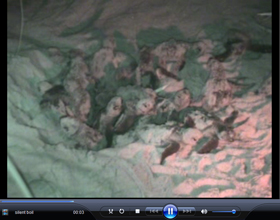Lights Out for Loggerheads
 View video of sea turtle boil by Barbara Bergwerf
View video of sea turtle boil by Barbara Bergwerf
List of sea turtle friendly lighting products
The support of South Carolina coastal residents is needed more than ever to raise awareness and educate our visitors to Keep Light’s Out for Loggerheads. The loggerhead (Caretta caretta) sea turtle nesting season is May through October. Nesting occurs on the beaches of South Carolina’s barrier islands. From May to mid-August, loggerheads come ashore to deposit approximately 120 eggs in a nest cavity in the dry sand dune system. Sixty days later, loggerhead hatchlings emerge from the nest at night and head to the ocean. Nests hatch from July through the end of October. During the nesting season, loggerheads may be disoriented by artificial lights. A disorientation event occurs when artificial light from man-made sources leads turtles away from the ocean. The causes of these disorientations include streetlights, gas station hood lights, city sky glow, exterior lights on commercial establishments, high density dwellings and beach front homes, including pool lights. People on or near the beach carrying flashlights or lanterns, bonfires, and landscape lighting can also disorient loggerhead hatchlings.
When loggerhead hatchlings emerge from the shell, they are attracted to the blue and green wavelengths of light which are naturally reflected off the ocean through celestial light. They use this natural light cue to navigate from the nest towards the ocean. This same mechanism is used by adult females when nesting. If an artificial light source on the beach is brighter than the natural light, the hatchlings will head towards this artificial source. These artificial lights can be a direct source such as a beach front home’s exterior flood light or a street light; the artificial light can also be indirect, light pollution that creates a sky glow effect.
When a hatchling sea turtle is attracted away from the ocean towards a direct or indirect source of light, biologists describe this as a disorientation event. The hatchlings become disoriented and crawl away from the ocean towards the brightest light. During this disorientation event, hatchlings are more susceptible to nocturnal predators and desiccation. While crawling the wrong way on the beach, hatchlings exhaust valuable, limited energy stores needed to swim offshore. Hatchlings need energy once they reach the ocean to swim towards floating Sargassum seaweed found as far as 60 miles offshore. They use the seaweed as camouflage to protect them from predators. The seaweed is also home to small crustaceans that loggerhead hatchlings eat to replenish their energy.
Loggerheads are listed as threatened under the Endangered Species Act and are protected by federal and state laws. The loggerhead nesting population in the southeastern United States is continuing to decline and it has been recommended that this species be reclassified from threatened to endangered. If a sea turtle hatchling is disoriented by artificial light, the maximum federal fine for harming a threatened species is $25,000. County and local lighting ordinances exist to protect sea turtles. To see a list of lighting ordinances in South Carolina, please visit: http://www.dnr.sc.gov/seaturtle/volres/ordinances.pdf. Violating local or county lighting ordinances carry fines up to $500.
As coastal development continues to increase, the number of disorientation events will also rise. If sea turtle friendly light fixtures and bulbs are used, this increasing trend can be reversed. Sustainable development allows for sea turtles and people to coexist in the beachfront communities. To learn more about available sea turtle friendly products, please visit this web page for a list of sea turtle friendly products.



